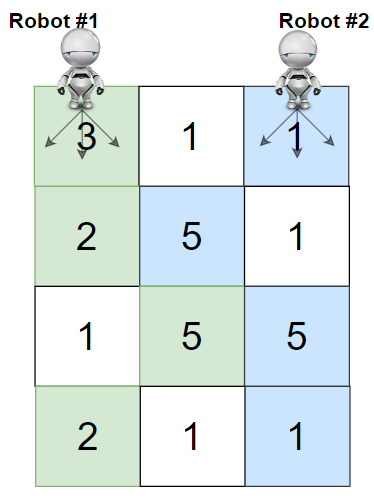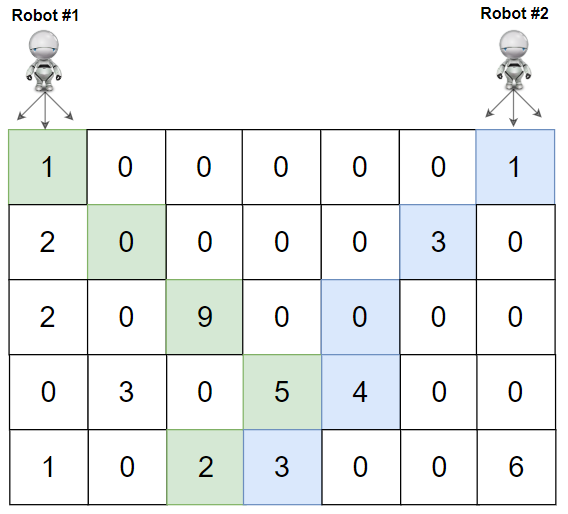1463. Cherry Pickup II (H)
Cherry Pickup II (H)
题目
Given a rows x cols matrix grid representing a field of cherries. Each cell in grid represents the number of cherries that you can collect.
You have two robots that can collect cherries for you, Robot #1 is located at the top-left corner (0,0) , and Robot #2 is located at the top-right corner (0, cols-1) of the grid.
Return the maximum number of cherries collection using both robots by following the rules below:
- From a cell (i,j), robots can move to cell (i+1, j-1) , (i+1, j) or (i+1, j+1).
- When any robot is passing through a cell, It picks it up all cherries, and the cell becomes an empty cell (0).
- When both robots stay on the same cell, only one of them takes the cherries.
- Both robots cannot move outside of the grid at any moment.
- Both robots should reach the bottom row in the
grid.
Example 1:

Input: grid = [[3,1,1],[2,5,1],[1,5,5],[2,1,1]]
Output: 24
Explanation: Path of robot #1 and #2 are described in color green and blue respectively.
Cherries taken by Robot #1, (3 + 2 + 5 + 2) = 12.
Cherries taken by Robot #2, (1 + 5 + 5 + 1) = 12.
Total of cherries: 12 + 12 = 24.
Example 2:

Input: grid = [[1,0,0,0,0,0,1],[2,0,0,0,0,3,0],[2,0,9,0,0,0,0],[0,3,0,5,4,0,0],[1,0,2,3,0,0,6]]
Output: 28
Explanation: Path of robot #1 and #2 are described in color green and blue respectively.
Cherries taken by Robot #1, (1 + 9 + 5 + 2) = 17.
Cherries taken by Robot #2, (1 + 3 + 4 + 3) = 11.
Total of cherries: 17 + 11 = 28.
Example 3:
Input: grid = [[1,0,0,3],[0,0,0,3],[0,0,3,3],[9,0,3,3]]
Output: 22
Example 4:
Input: grid = [[1,1],[1,1]]
Output: 4
Constraints:
rows == grid.lengthcols == grid[i].length2 <= rows, cols <= 700 <= grid[i][j] <= 100
题意
给定一个二维数组,两个机器人分别放在左上角和右上角,每次只能向下走一行,且位置最多只能改变一列,求路径上所有数字之和的最大值(两机器人重合时只计算一次所在数字)。
思路
动态规划。记dp[row][x][y]为在第row行,且两机器人分别在该行x列和y列时得到的最大和。而要走到(row, x, y)这个位置,上一行的位置只会有9个可能:(row - 1, x - 1 ~ x + 1, y - 1 ~ y + 1)。所以只要计算这9个位置中的最大值,再加上当前位置对应的数字,就能得到dp[row][x][y]。递推式:
\[dp[row][x][y]=
\begin{cases}
\begin{align}
&\max_{-1 \le d_x \le 1, -1 \le d_y \le 1}(dp[row-1][x+d_x][y+d_y])\ +\ grid[row][x]\ +\ grid[row][y],&x\ne y\\
&\max_{-1 \le d_x \le 1, -1 \le d_y \le 1}(dp[row-1][x+d_x][y+d_y])\ +\ grid[row][x],&x=y
\end{align}
\end{cases}
\]
可以用滚动数组优化,只需要记录2行的数据。
代码实现
Java
public class Solution {
public int cherryPickup(int[][] grid) {
int ans = 0;
int len = grid[0].length;
Integer[][][] dp = new Integer[2][len][len]; // null即为不可达
dp[0][0][len - 1] = grid[0][0] + grid[0][len - 1];
for (int row = 1; row < grid.length; row++) {
int curRow = row % 2, preRow = (row + 1) % 2;
for (int x = 0; x < len; x++) {
for (int y = 0; y < len; y++) {
Integer max = null;
for (int i = -1; i <=1 ; i++) {
for (int j = -1; j <= 1; j++) {
if (x + i < len && x + i >= 0 && y + j < len && y + j >= 0 && dp[preRow][x + i][y + j] != null) {
max = max == null ? dp[preRow][x + i][y + j] : Math.max(max, dp[preRow][x + i][y + j]);
}
}
}
// 注意当前位置可能是不可达的
dp[curRow][x][y] = max == null ? null : max + grid[row][x] + (x == y ? 0 : grid[row][y]);
if (dp[curRow][x][y] != null) {
ans = Math.max(ans, dp[curRow][x][y]);
}
}
}
}
return ans;
}
}





